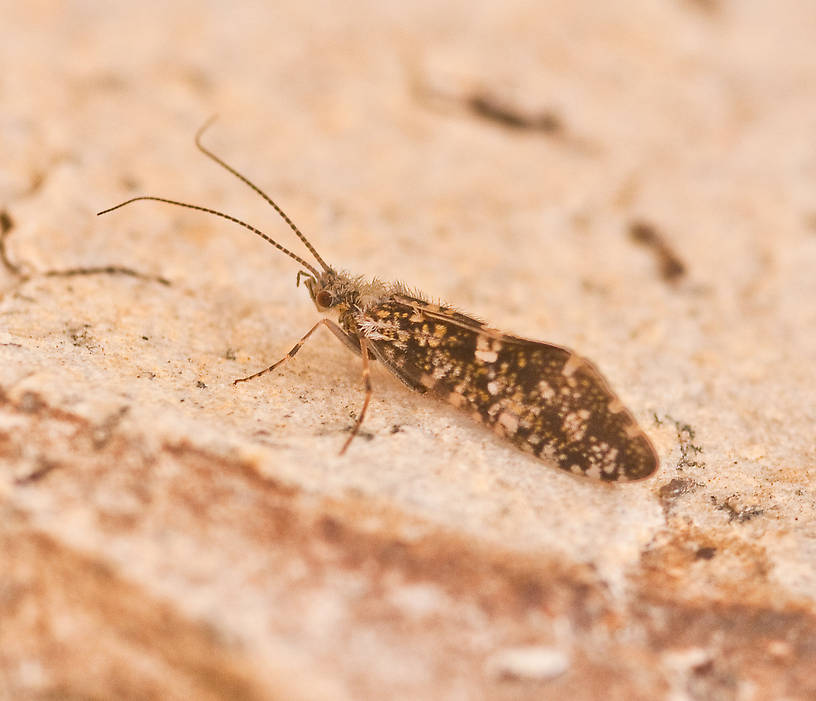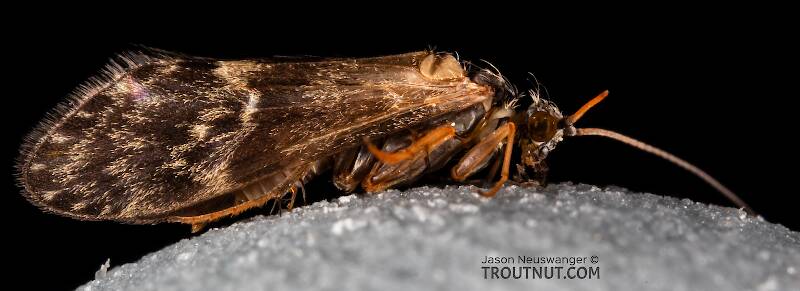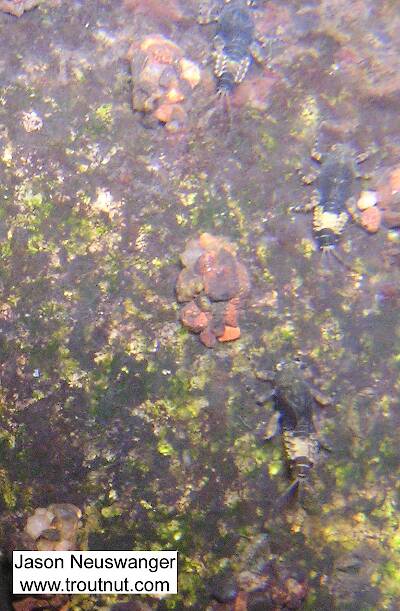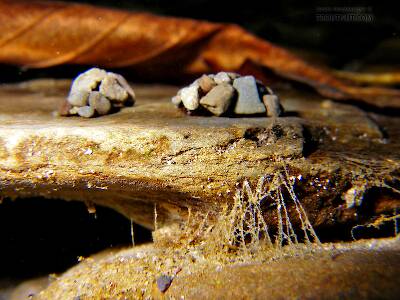
Blue-winged Olives
Baetis
Tiny Baetis mayflies are perhaps the most commonly encountered and imitated by anglers on all American trout streams due to their great abundance, widespread distribution, and trout-friendly emergence habits.
Featured on the forum

Nymphs of this species were fairly common in late-winter kick net samples from the upper Yakima River. Although I could not find a key to species of Zapada nymphs, a revision of the Nemouridae family by Baumann (1975) includes the following helpful sentence: "2 cervical gills on each side of midline, 1 arising inside and 1 outside of lateral cervical sclerites, usually single and elongate, sometimes constricted but with 3 or 4 branches arising beyond gill base in Zapada cinctipes." This specimen clearly has the branches and is within the range of that species.

Troutnut is a project started in 2003 by salmonid ecologist Jason "Troutnut" Neuswanger to help anglers and
fly tyers unabashedly embrace the entomological side of the sport. Learn more about Troutnut or
support the project for an enhanced experience here.
Caddisfly Genus Glossosoma (Little Brown Short-horned Sedges)
The sporadic emergence of these caddisflies diminishes the importance of the freshly emerged adults and pupae, but they have unique periods of vulnerability as larvae during the day and again as diving egg layers at dusk that can make them very important. A taxon can only have one common name attached in the title but this is one of those genera whose species come in a variety of colors and descriptive common names. In the West their bodies generally come in tan to brown shades with matching wings, their wings can be speckled grayish tan or even almost black as with an eastern species. Some western rivers have astounding populations. See Glossosomatidae for more information.
Where & when
Preferred waters: Riffle sections
In 313 records from GBIF, adults of this genus have mostly been collected during July (28%), June (25%), April (12%), August (11%), May (11%), and September (7%).
In 123 records from GBIF, this genus has been collected at elevations ranging from 3 to 9239 ft, with an average (median) of 699 ft.
Genus Range
Egg-Laying behavior
Time of day: evenings, often at last light
Larva & pupa biology
Current speed: Fast, for most species
Shelter type: Rocks, shaped kind of like a turtle shell
This usually occurs several times during their development in the spring and summer. In Caddisflies, LaFontaine recommends imitating the naked pinkish-colored larvae drifting without their cases. They also come in shades of pale tan or yellow.
Specimens of the Caddisfly Genus Glossosoma
1 Adult
2 Male Adults
1 Larva

I caught this tiny larva without a case, but it seems to key pretty clearly to to Glossosomatidae. From there, the lack of sclerites on the mesonotum points to either Glossosoma or Anagapetus. Although it's difficult to see in a 2D image from the microscope, it's pretty clear in the live 3D view that the pronotum is only excised about 1/3 of its length to accommodate the forecoxa, not 2/3, which points to Glossosoma at Couplet 5 of the Key to Genera of Glossosomatidae Larvae.
2 Underwater Pictures of Glossosoma Caddisflies:
Discussions of Glossosoma
Glossosoma intermedium or nigrior
5 replies
Posted by Wiflyfisher on Jun 30, 2020
Last reply on Jul 31, 2020 by Creno
pupa color
7 replies
Start a Discussion of Glossosoma
References
- Baumann, Richard W. 1975. Revision of the Stonefly Family Nemouridae (plecoptera) : a Study Of The World Fauna At The Generic Level. Smithsonian Contributions to Zoology undef(211): 1-74.
- LaFontaine, Gary. 1981. Caddisflies. The Lyons Press.
- Schwiebert, Ernest G. 1955. Matching the Hatch. MacMillan Publishing Company.
- Swisher, Doug and Carl Richards. 2000. Selective Trout. The Lyons Press.
Caddisfly Genus Glossosoma (Little Brown Short-horned Sedges)
Taxonomy
Species in Glossosoma
Glossosoma alascense
1
8
Glossosoma califica
0
0
Glossosoma intermediumSmall Grey Sedge
0
0
Glossosoma lividum
0
0
Glossosoma montana
0
0
Glossosoma nigrior
0
0
Glossosoma penitum
0
0
Glossosoma traviatum
0
0
Glossosoma velona
0
0
Species in Glossosoma: Glossosoma alascense, Glossosoma califica, Glossosoma intermedium, Glossosoma lividum, Glossosoma montana, Glossosoma nigrior, Glossosoma penitum, Glossosoma traviatum, Glossosoma velona
13 species (Glossosoma bruna, Glossosoma excita, Glossosoma idaho, Glossosoma mereca, Glossosoma oregonense, Glossosoma parvula, Glossosoma pterna, Glossosoma pyroxum, Glossosoma schuhi, Glossosoma sequoia, Glossosoma ventralis, Glossosoma verdona, and Glossosoma wenatchee) aren't included.







